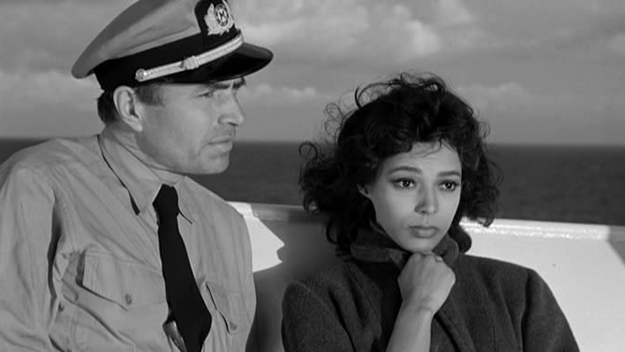TCM Diary: The Decks Ran Red

James Mason and Dorothy Dandridge in The Decks Ran Red (Andrew L. Stone, 1958)
Page one of the October 12, 1905 edition of The New York Times features the headline “Mutineers Kill Five, Including the Captain,” preceding a description of the deadly events aboard the SS Berwind: “the decks of the schoner [sic] crimson with blood.” Bodies not left on deck had been foisted overboard, including that of its Captain Rummill, and “three negroes,” led by one Henry Scott, had been detained. A contretemps over the quality of the coffee was improbably offered as the massacre’s origin. A subsequent (rampantly editorializing) article in the Wilmington Messenger posited that the mutineers’ plan was to waterlog the vessel and claim to be the sole survivors of a storm hit. Maritime law at the time would then award them part of the value of the salvage.
A half-century later, MGM dramatized and generously modified this sordid blot on seafaring in The Decks Ran Red, the opening titles of which assure us that this is “A story which actually happened… the most infamous, diabolically cunning crime in the annals of Maritime history.” To hammer home the point, the “Red” of the title card “drips” with animated black-and-white blood, a nice touch. Reliable studio workhorse Andrew L. Stone wrote and directed, and also produced together with his wife Virginia L. Stone, who edited. Stone’s unadorned direction serves a banal sense of menace that the sterile, largely music-free presentation only serves to boost.
Foggy gloom pervades the 1958 film from the start, in which the Berwind’s previous captain’s body is jettisoned for burial at sea, after death under mysterious circumstances. Multiple mates announce that they’ll refuse to sail with her again, and the rottenness at the core of the crew’s morale is personified by Henry Scott. Here Scott is a white man played by Broderick Crawford, among the most singular physical presences in cinema; the racial switch perhaps allowed the studio to skirt thorny issues of subjugation and racial rebellion that truer representation would have forced. Scott and his accomplice Leroy (hirsute fireplug Stuart Whitman) immediately announce their willingness to murder everyone onboard to collect the $1 million salvage payout. They’re tickled to learn of the ship’s new, greenhorn Captain Edwin Rummill (James Mason), whom they assume can be manipulated or dispensed with easily. Rummill takes the assignment against his wife’s wishes because “a man must,” but starts regretting it upon seeing the rickety Berwind (his voiceover: “The nearer I approached her, the more depressed I’d get”).
Soon after the ship sets sail, Scott and Leroy begin sowing rancor among the crew in pursuit of their salvage scheme. An added source of unruliness comes from the crew’s reaction to the ship’s steward, Mahia (Dorothy Dandridge), who was brought aboard by her husband, the Maori cook Pete (Joel Fluellen). Feeding the volatility of the otherwise all-male crew, the stage is set for the film’s rousingly action-filled second half. The capper is a brutally matter-of-fact bloodbath (rifle-shot murders in the engine room accompanied by the chilling popping sound of the guns’ reports) which Rummill and Mahia conspire to thwart.
Stone’s diversified portfolio isn’t all crime-ridden, though he made several solid noirs including The Steel Trap (1952) and Cry Terror! (also 1958 and also starring Mason). He helmed the delightful Stormy Weather, a 1943 musical biopic of Bill “Bojangles” Robinson that stars Bojangles himself and features rare filmed performances by titans like co-lead Lena Horne, Fats Waller, Cab Calloway, and the Nicholas Brothers. Its innovation (along with the same year’s Cabin in the Sky) as a mainstream musical with an entirely black cast connects it directly to Otto Preminger’s all-black Carmen Jones (1954), the film that propelled Dandridge to major stardom. Dandridge was nominated for an Academy Award for her performance as the sashaying, colorfully clad free spirit Carmen. It could have been a stepping stone to yet greater heights, but a combination of factors including industry racism, personal insecurity, and the influence of Preminger, who advised her to only accept starring roles, curtailed her rise. Dandridge would also star in Preminger’s Porgy and Bess (1959), but eventually did have to settle for supporting roles in films like The Decks Ran Red and the soapily libidinous interracial affair drama Island in the Sun (1957, co-starring Mason) for the few remaining years of her career, before a drug overdose in 1965 killed her at 42.
Even in these smaller roles, the star power of the spellbinding former stage singer radiates. And in The Decks Ran Red, Dandridge’s Mahia has a full arc, maturing from a flirty layabout complaining about staying in her cabin to a canny manipulator who cozies up to murderous Leroy before snatching the gun from his waist and shooting him twice point-blank. The ever-watchable Mason delivers a committed if standard performance as Rummill, who must feign outrage when he’s (rightly) accused by the mutineers of having eyes for Mahia, and who snaps into quick-thinking action once bodies start accruing. But it is Crawford who seems most in tune with the film’s sense of unventilated ill-will and avarice—his Scott is like a diseased barnacle on the cursed ship, who’s so at home on board he might as well have been born there. Tossing one turtlenecked would-be conspirator overboard in broad daylight brings a smirk of joy to his saggy face, and he has no qualms shooting others in the back. Crawford’s Scott might be his most hateful creation (among more than a few), and deserves inclusion in the pantheon of seafaring cinematic villains like Robert Ryan’s Claggart (Billy Budd) and Edward G. Robinson’s Wolf Larsen (The Sea Wolf)—a proud lineage of disgrace.
The Decks Ran Red airs April 3 on Turner Classic Movies.
Justin Stewart is a writer whose work has appeared in Brooklyn magazine, Reverse Shot, and elsewhere.







